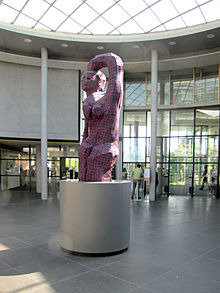Georg Baselitz
dal 6/6/2013 al 1/11/2013
Segnalato da
6/6/2013
Georg Baselitz
Galerie Thaddaeus Ropac - Pantin, Paris
Sculptures & black painting. From the beginning, his work has been marked by a visceral reaction to human trauma and tragedy, particularly with relation to German history. Baselitz was also heavily influenced by Art Brut, by the writings and drawings of Antonin Artaud and by African sculpture.

Galerie Thaddaeus Ropac presents, in the
Pantin exhibition space inaugurated in
October 2012, a comprehensive exhibition
with new monumental sculptures by one of
the most distinguished German artists,
Georg Baselitz.
Chronologically, the exhibition takes up
where the Musée d’Art Moderne de la Ville
de Paris left off in its Baselitz sculpture
retrospective of September 2011 - January 2012. The past two years have seen the
creation of five new large - scale sculptures,
which will be presented to the public for the first time in the Pantin gallery.
"What is Germany, really, in regard to traditional sculpture?” in a recent interview, Baselitz looked
back to questions he asked h
imself in the 1970s:
"The last thing I could think of in the way of
pleasing or characteristic German sculpture after the Gothic period was the group
Die
Brücke, including Schmidt - Rottluff, Kirchner and Lehmbruck. When I finally arrived at this idea, I took a
piece of wood and started work" (Georg Baselitz, 2011).
Baselitz's first sculpture was shown in the German Pavilion at the 1980 Venice Biennale. Since
then he has made only a few.
After Edgar Degas and Paul Gauguin, artists such as Umberto Boccioni,
Pablo Picasso,
Henri
Matisse and Max Ernst chose readily malleable material as soon as they arrived at the limits of
painting. Baselitz stands in this tradition of painters who
leave their medium.
He finds sculpture
"a shorter way than painting", to tackle
certain problems; it is "more primitive, brutal, not as
reserved [...] as painting can sometimes be", and "less c
ryptic tha
n pictures, far more direct,
more
legible" (Georg Baselitz,
1983).
Besides this recourse to Expressionist sculpture, an important f
ield of reference for Baselitz's
sculpture is the
fundamental
nature of African sculpture, where specific basic types
have been
developed over a long period.
Baselitz works exclusively with wood, negating both the idea of doing justice to the material and
that of the stuffy, conservative reputation of wood sculpture. "Any appealing form [..] any arty
-
crafty elegance or deliberate construction is taboo" (Georg Baselitz, 1987). With great physical
effort, he hacks, stabs and saws the block of wood, taking no
account of the grain. "For a
sculpture to take shape, the wood has to be forcibly opened" (Uwe Schneede, 1993).
For the past ten years, Baselitz has had limited editions of
his
wood sculptures cast in bronze at
the long
-
established Hermann Noack fine art
foundry in Berlin. Here the finest details of the
sculpted wood are reproduced. In Pantin, the five wood sculptures will for the first time be
juxtaposed with their bronze versions.
The sculptures on show are: a seated figure evoking the
Ecce Homo
; a sta
nding couple with
arms interlinked; a group of
towering
figures reminiscent of the iconographic
Three Graces
; and
two fetishistic sculptures showing a humanoid figure enclosed in rings.
In the
past months
Baselitz has been working on a
new block of works
entitled
Black
Paintings.
After the series
Blackout
(2009) and
The Negative
(2012), a series in black would seem to be a
logical
step. Recently, Baselitz has frequently been quoted in the press as saying: "I dream of
painting an invisible picture".
Expressi
ve representations of birds and human figures may be
discerned in
these pictures, though the shades Baselitz uses render them almost invisible. The
figuration is revealed more through the highly structured surface of the
heavy
layers of black,
dark blue an
d brown, which give the surface a soft, waxy effect almost like encaustic pai
nting
–
as used by Jasper Johns
in the 1950s.
In Pantin, t
his bold series of paintings will be shown for
the first time.
Georg Baselitz was born Hans
-
Georg Kern in 1938 in Deuts
chbaselitz, Saxony. From the
beginning, his work has been marked by a visceral reaction to human trauma and tragedy,
particularly with relation to German history. Baselitz was also heavily influenced by “Art Brut,” by
the writings and drawings of Antonin
Artaud and by African sculpture.
Georg Baselitz’s works have been the subject of numerous, international solo and group
exhibitions since the early 1960s. His first major retrospective took place at the Solomon R.
Guggenheim in New York in 1995, which we
nt on to the Los Angeles County Museum, the
Hirshhorn Museum and Sculpture Garden in Washington, D.C., the Nationalgalerie in Berlin and,
in 1996, to the Musée d’art Moderne de la Ville de Paris. A second, significant retrospective took
place at the Royal
Academy in London in 2007, and two important shows have just taken place
on the artist’s 50 years of painting and 30 years of sculpting at the Museum Frieder Burda and
the Stattliche Kunsthalle in Baden
-
Baden.
On the occasion of his 75
th
birthday, the Ess
l Museum
is dedicating a retrospective of Baselitz’s work, on view until 20 May 2013.
An exhibition catalogue will be published in conjunction with the exhibition.
Opening on Friday 7 June, with the artist present, from 6pm to 8pm.
Galerie Thaddaeus Ropac
69, avenue Général Leclerc, Paris
Hours: Tuesday – Saturday, 10am to 7pm
Free Admission



